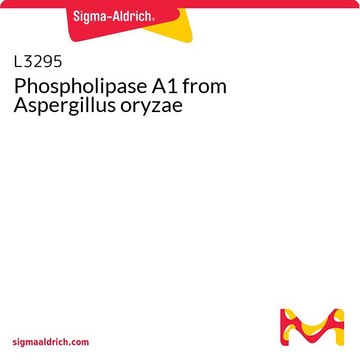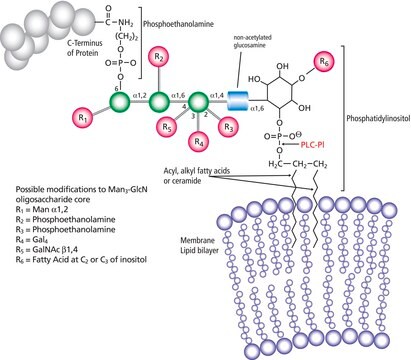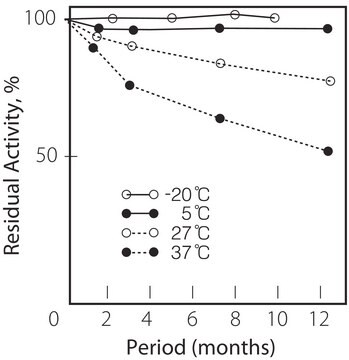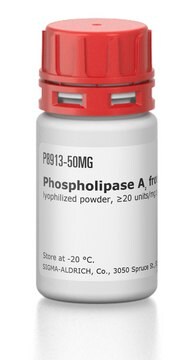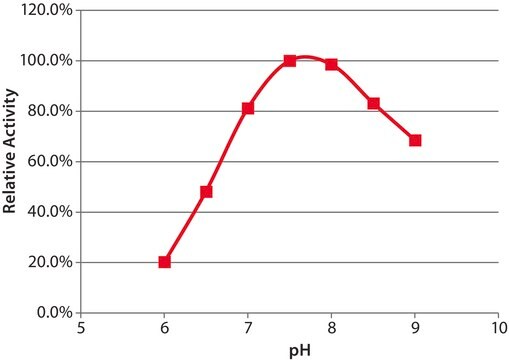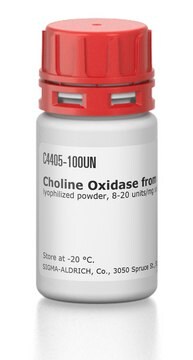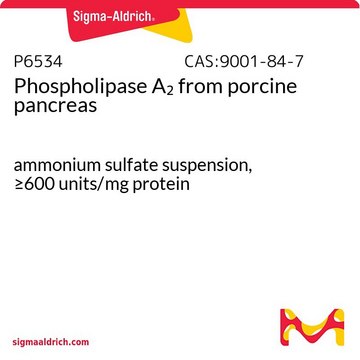P4912
Phospholipase D from Streptomyces sp.
Type VII, lyophilized powder, ≥150 units/mg solid
Sinônimo(s):
Lecithinase D, Phosphatidylcholine phosphatidohydrolase
Faça loginpara ver os preços organizacionais e de contrato
About This Item
Produtos recomendados
fonte biológica
Streptomyces sp.
Nível de qualidade
tipo
Type VII
forma
lyophilized powder
atividade específica
≥150 units/mg solid
temperatura de armazenamento
−20°C
Aplicação
Phospholipase D (PLD) has been used to hydrolyze the phosphate bonds of phospholipids and sphingomyelin to yield the corresponding phosphatidic acid. It has also been used to study metabolic labeling and direct imaging of choline phospholipids in vivo by measuring propargyl-Cho incorporation. Furthermore, PLD has been used in purification and kinetic studies.
The enzyme from Sigma has been used in the translocation of sphingosine kinase 1 (SK1) to membrane fractions under in vitro conditions. It has also been used to produce phosphatidic acid (PA) from phosphatidylcholine (PC) in HL60 permeabilized cells.
Ações bioquímicas/fisiológicas
Phospholipase D is glycerophospholipid-specific. It is markedly less active on sphingomyelins and lysophospholipids. Phospholipase D hydrolyzes the phosphate bonds of phospholipids and sphingomyelin to give the corresponding phosphatidic acid.
Hydrolyzes the phosphate bonds of phospholipids and sphingomyelin to give the corresponding phosphatidic acid.
Embalagem
Bottomless glass bottle. Contents are inside inserted fused cone.
Definição da unidade
One unit will liberate 1.0 μmole of choline from 1,2-Dioleoyl-sn-glycero-3-phosphocholine per hour at pH 8.0 at 37 °C.
Nota de análise
Protein by biuret
Palavra indicadora
Danger
Frases de perigo
Declarações de precaução
Classificações de perigo
Resp. Sens. 1
Código de classe de armazenamento
11 - Combustible Solids
Classe de risco de água (WGK)
WGK 3
Equipamento de proteção individual
Eyeshields, Gloves, type N95 (US)
Certificados de análise (COA)
Busque Certificados de análise (COA) digitando o Número do Lote do produto. Os números de lote e remessa podem ser encontrados no rótulo de um produto após a palavra “Lot” ou “Batch”.
Já possui este produto?
Encontre a documentação dos produtos que você adquiriu recentemente na biblioteca de documentos.
Os clientes também visualizaram
Mohamed H Yaghmour et al.
Journal of lipid research, 62, 100022-100022 (2021-01-17)
Phospholipids with a choline head group are an abundant component of cellular membranes and are involved in many important biological functions. For studies on the cell biology and metabolism of these lipids, traceable analogues where propargylcholine replaces the choline head
Kathryn Garner et al.
The Journal of biological chemistry, 287(38), 32263-32276 (2012-07-24)
Phosphatidylinositol transfer proteins (PITPs) are versatile proteins required for signal transduction and membrane traffic. The best characterized mammalian PITPs are the Class I PITPs, PITPα (PITPNA) and PITPβ (PITPNB), which are single domain proteins with a hydrophobic cavity that binds
Christine Delon et al.
The Journal of biological chemistry, 279(43), 44763-44774 (2004-08-18)
Sphingosine kinase 1 (SK1) phosphorylates sphingosine to generate sphingosine 1-phosphate (S1P). Because both substrate and product of the enzyme are potentially important signaling molecules, the regulation of SK1 is of considerable interest. We report that SK1, which is ordinarily a
Franka Voigt et al.
RNA (New York, N.Y.), 18(12), 2128-2134 (2012-10-23)
Piwi-interacting RNAs (piRNAs) are a gonad-specific class of small RNAs that associate with the Piwi clade of Argonaute proteins and play a key role in transposon silencing in animals. Since biogenesis of piRNAs is independent of the double-stranded RNA-processing enzyme
Milya Davlieva et al.
Antimicrobial agents and chemotherapy, 57(1), 289-296 (2012-11-02)
Daptomycin (DAP) resistance in enterococci has been linked to mutations in genes that alter the cell envelope stress response (CESR) (liaFSR) and changes in enzymes that directly affect phospholipid homeostasis, and these changes may alter membrane composition, such as that
Nossa equipe de cientistas tem experiência em todas as áreas de pesquisa, incluindo Life Sciences, ciência de materiais, síntese química, cromatografia, química analítica e muitas outras.
Entre em contato com a assistência técnica

